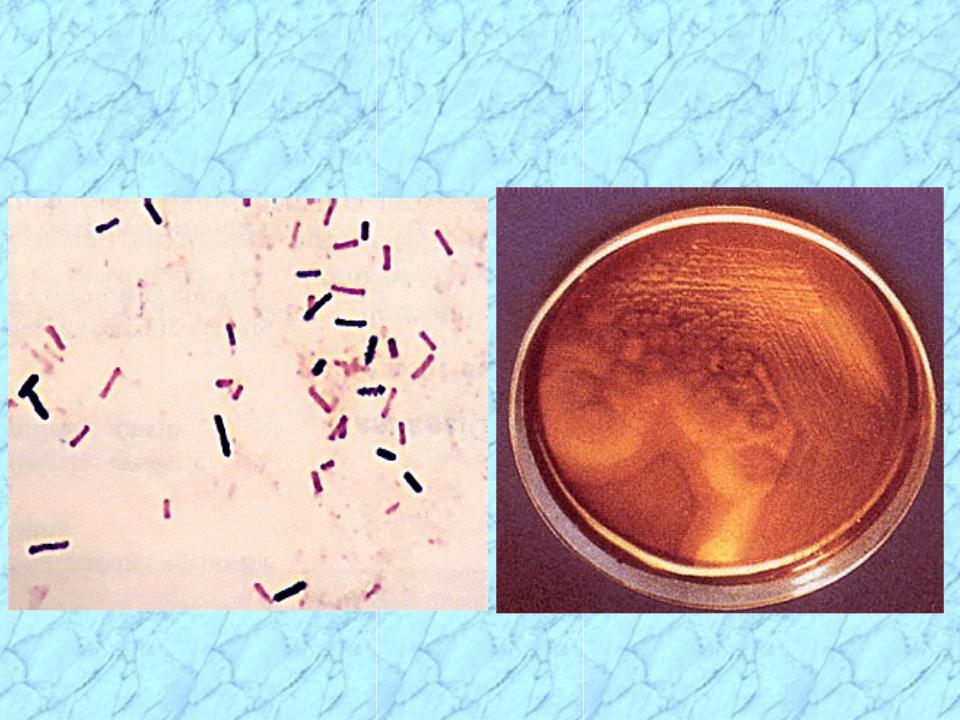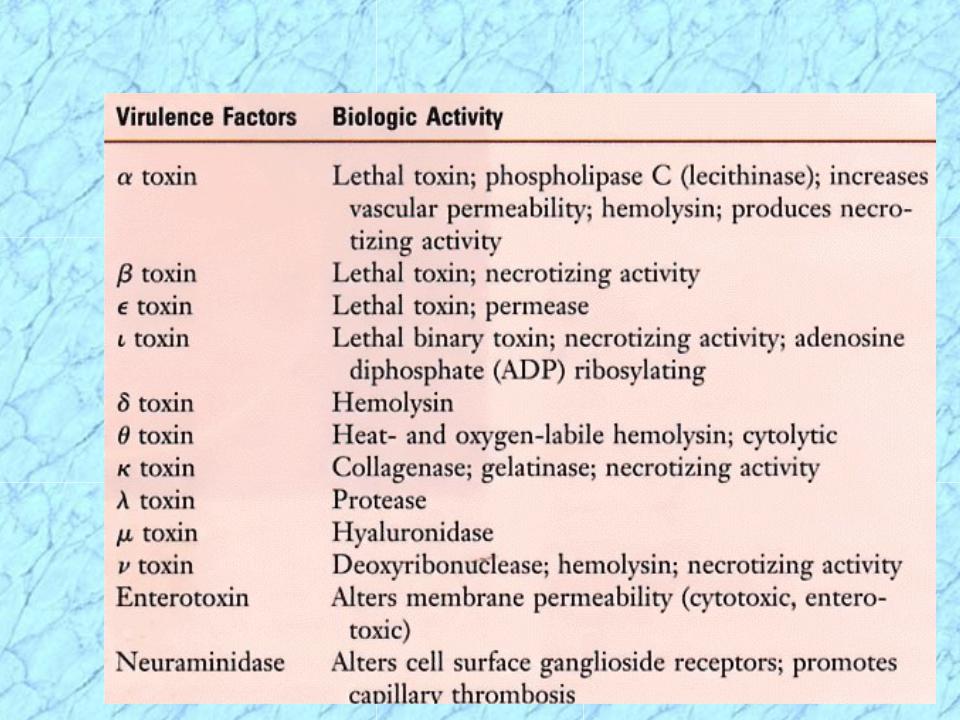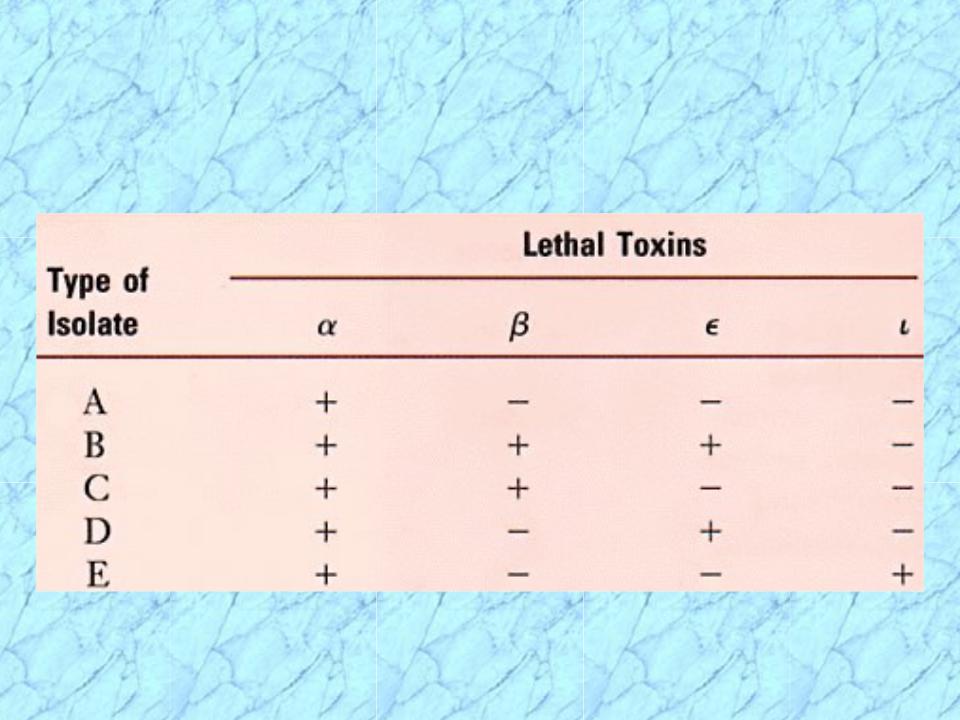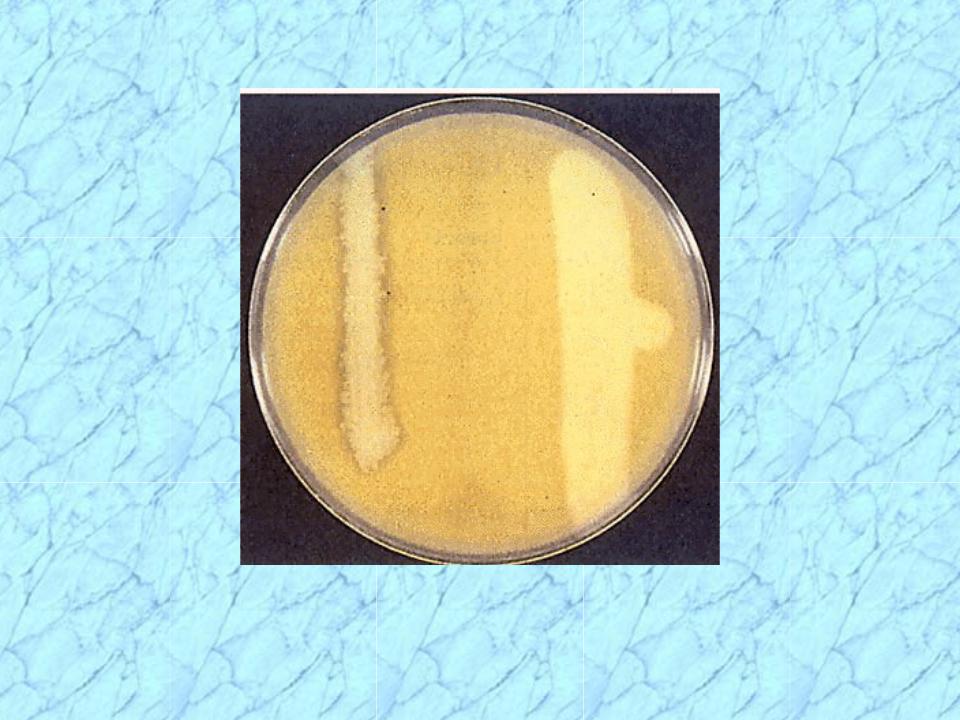
- •Clostridium
- •See Lecture Handouts
- •Clostridium spp. Anaerobic Gram-Positive Spore-Forming Bacilli
- •Spores
- •Clostridium Associated Human Disease
- •Clostridium perfringens
- •Clostridium perfringens — histotoxic or enterotoxigenic infections
- •Summary of C. perfringens Infections
- •Micro & Macroscopic C. perfringens
- •Summary of C. perfringens Infections (cont.)
- •Clostridial Cellulitis
- •C. perfringens Virulence Factors
- •Exotoxins Associated with C. perfringens Types A-E
- •C. perfringens Nagler Reaction
- •Clostridium tetani
- •Clostridium tetani — agent of tetanus
- •Summary of C. tetani Infections
- •Summary of Clostridium tetani Infections (cont.)
- •Clostridium tetani Gram Stain
- •Clinical Forms of Tetanus
- •Opisthotonos in Tetanus Patient
- •Risus Sardonicus in Tetanus Patient
- •Mechanism of Action
- •Clostridium botulinum
- •Summary of C. botulinum Infections
- •Summary of C. botulinum Infections
- •C. botulinum — agent of botulism, a rare, but severe (lethal) neuroparalytic disease
- •Mechanism of Action
- •Rates of
- •Clostridium dificile
- •Summary of
- •Summary of
- •Antibiotic-
- •Antibiotic-Associated Colitis
- •C. dificile Virulence Factors
- •Other Clostridium
- •Virulence
- •REVIEW
- •Clostridium spp. Anaerobic Gram-Positive Spore-Forming Bacilli
- •See Lecture Handouts
- •Spores
- •Review of Clostridium perfringens
- •Clostridium perfringens — histotoxic or enterotoxigenic infections
- •Micro & Macroscopic C. perfringens
- •C. perfringens Virulence Factors
- •Exotoxins Associated with C. perfringens Types A-E
- •C. perfringens Nagler Reaction
- •Review of Clostridium tetani
- •Clostridium tetani — agent of tetanus
- •Clostridium tetani Gram Stain
- •Clinical Forms of Tetanus
- •Mechanism of Action
- •Review of Clostridium botulinum
- •C. botulinum — agent of botulism, a rare, but severe (lethal) neuroparalytic disease
- •Mechanism of Action
- •Review of Clostridium dificile
- •Summary of
- •Summary of

See Lecture Handouts
REVIEW

Spores
Clostridium form endospores under adverse environmental conditions
Spores are a survival mechanism
Spores are characterized on the basis of position, size and shape
Most Clostridium spp., including C. perfringens and C. botulinum, have ovoid subterminal (OST) spores
C. tetani have round terminal (RT) spores
REVIEW

Review of Clostridium perfringens
REVIEW

Clostridium perfringens — histotoxic or enterotoxigenic infections
Morphology and Physiology
•large, rectangular bacilli (rod) staining gram-positive
•spores rarely seen in vitro or in clinical specimens (ovoid, subterminal)
•non-motile, but rapid spreading growth on blood agar mimics growth of motile organisms
•aerotolerant, especially on media supplemented with blood
•grow at temperature of 20-50°C (optimum 45°C) and pH of 5.5-8.0
Pathogenicity Determinants (note that toxins include both cytolytic enzymes and bipartite exotoxins)
•four major lethal toxins (alpha ( ), beta ( ), epsilon ( ), and iota ( ) toxins) and an enterotoxin
•six minor toxins (delta( ), theta( ), kappa( ), lambda( ), mu( ), nu( )toxins) & neuraminadase
•C. perfringens subdivided into five types (A-E) on basis of production of major lethal toxins
•C. perfringens Type A (only major lethal toxin is alpha toxin) responsible for histotoxic and
enterotoxigenic infections in humans; Type C causes necrotizing enteritis (not in U.S.)
Lab Identification
•direct smear and Gram stain, capsules upon direct examination of wound smears
•culture takes advantage of rapid growth in chopped meat media at 45° C to enrich and then
isolate onto blood agar streak plate after four to six hours
•gas from glucose fermentation
•in vivo toxicity testing and identification of the specific toxin types involved
•double zone of hemolysis on blood agar (p-hemolytic theta(e) toxin, a-hemolytic alpha(oc) toxin)
•Nagler rxn; precipitation in serum or egg yolk media; oc -toxin (phospholipase C) is a lecithinase
•"stormy" fermentation (coagulaltion) of milk due to large amounts of acid and gas from lactose
Diagnosis/Treatment of systemic infection — Early diagnosis and aggressive treatment essential
•removal of necrotic tissue (surgical debridement)
•Penicillin G in high doses if more serious infection
Of poorly defined clinical value are:
• |
administration of antitoxin |
• |
hyperbaric oxygen (dive chamber) adjunct therapy (??inhibit growth of anaerobe??) REVIEW |

Micro & Macroscopic C. perfringens
NOTE: Large rectangular |
NOTE: Double zone of hemolysis |
gram-positive bacilli |
|
REVIEW
Inner beta-hemolysis = θ toxin Outer alpha-hemolysis = α toxin

C. perfringens Virulence Factors
Minor Major
REVIEW

Exotoxins Associated with C. perfringens Types A-E
Major
REVIEW

C. perfringens Nagler Reaction
NOTE: Lecithinase (α-toxin; phospholipase)
hydrolyzes phospholipids in egg-yolk agar around streak on right. Antibody against α-toxin inhibits
activity around left streak. |
REVIEW |

Review of Clostridium tetani

Clostridium tetani — agent of tetanus
Morphology and Physiology-
•long thin gram-positive organism that stains gram negative in old cultures
•round terminal spore gives drumstick appearance
•motile by peritrichous flagella
•grow on blood agar or cooked meat medium with swarming
•beta-hemolysis exhibited by isolated colonies
•spores resist boiling for 20 minutes
Antigenic Structure-
flagella (H), somatic (0), and spore antigens. Single antigenic toxin characterizes all strains.
Pathogenicity Determinants"
•play a role in local infection only in conjunction with other bacteria that create suitable environment for their invasion
•systemic-acting, plasmid-mediated A-B neurotoxin (tetanospasmin) produced intracellularly
Mode of Action — one of most poisonous substances
•binds gangliosides in synaptic membranes (synapses of neuronal cells) and blocks
release of inhibitory neurotransmitters; continuous stimulation by excitatory transmitters
• muscle spasms (spastic paralysis) (trismus (lockjaw), risus sardonicus, opisthotonos), cardiac arrhythmias, fluctuations in blood pressure
Lab Identification"
• use characteristics of resistance to heat, motility, and toxin production to help identify
Diagnosis/Treatment/Prevention
•empirical diagnosis on basis of clinical manifestations
•treat to prevent elaboration and absorption of toxin
clean wound (debridement), control spasms
metronidazole administered to eliminate vegetative bacteria that produce neurotoxin
passive immunity (human tetanus immunoglobulin); vaccination (active) as preventative
antitoxin administered to bind free tetanospasmin
REVIEW
